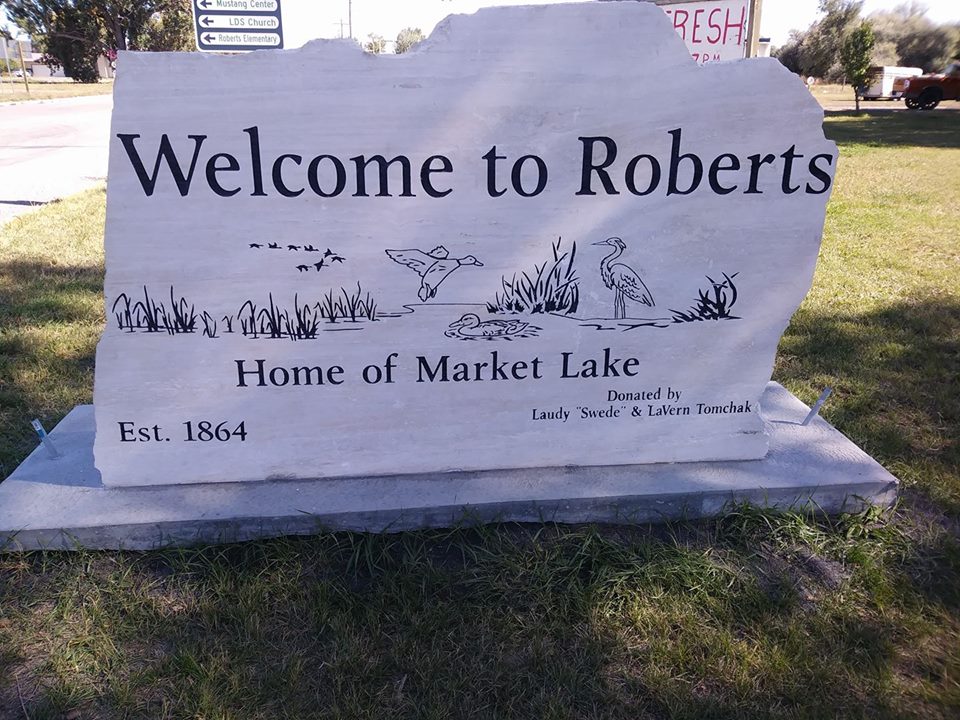About Us
About Us.
Nestled in the heart of Jefferson County, Roberts is a charming small town located about 14 miles northeast of Idaho Falls. With a population of 531, according to the 2020 U.S. Census, Roberts offers a peaceful and close-knit community where residents enjoy the simplicity and beauty of rural living.
Roberts has a rich agricultural heritage, with farming and ranching being the primary industries that sustain the town. The community thrives on its rural traditions, with small businesses like a grocery store, gas station, and local restaurants offering a variety of services. The town also boasts a public park and a community center, which hosts events and activities throughout the year, further strengthening the sense of community.
While Roberts offers a quiet, laid-back lifestyle, it’s also surrounded by a wealth of outdoor attractions and recreational opportunities that make it an ideal location for nature lovers. The town is home to several fishing spots, including Jim Moore Pond, just 10 miles northeast of Roberts, where visitors can enjoy peaceful fishing and birdwatching. The Snake River Fishing Dock, located a short drive from town, and the renowned Henry's Fork of the Snake River also offer excellent fishing experiences. The Market Lake Wildlife Management Area is a prime location for birdwatching and outdoor exploration, where visitors can witness a variety of wildlife species in their natural habitat.
In addition to these water-based activities, Roberts is surrounded by stunning landscapes perfect for hiking and wildlife viewing. The Craters of the Moon National Monument, with its unique volcanic terrain, offers trails for hikers to explore, while the Menan Buttes, two large volcanic cones, provide opportunities for scenic hikes and spotting local wildlife.
For those looking to venture a bit farther, Island Park offers camping, hiking, and fishing, while Yellowstone National Park, known for its geothermal features, diverse wildlife, and breathtaking landscapes, is just a short drive away. Wildlife enthusiasts will be delighted by the variety of animals found in the area, including deer, elk, and numerous bird species that call this region home.
Roberts is the perfect blend of rural tranquility and natural beauty, offering residents and visitors a lifestyle enriched by agriculture, outdoor recreation, and a strong sense of community. Whether you’re seeking quiet moments in nature or exploring the region’s scenic wonders, Roberts is a place where you can truly enjoy the best of Idaho.
Our Beginnings.
The history of Roberts traces back to the early 19th century, when European and American explorers first ventured into the region. One of the earliest mentions of what would become Market Lake, the area’s original name, was by Osborne Russell, a trapper whose journal Journal of a Trapper – Nine Years in the Rocky Mountains (published posthumously) described the abundant wildlife and fertile lands he encountered in 1835. Russell noted the presence of American Indians, as well as numerous buffalo, antelope, and other game animals, which earned the area the name “Market Place” among trappers and indigenous peoples. This area, with its lush wetlands and diverse ecosystems, proved to be a prime hunting ground for those who passed through (Pettite, 1967).
In 1841, Father Pierre de Smet, a Catholic missionary, traveled through the region on his way to Fort Hall, and trappers associated with the Hudson’s Bay Company were also active in the area. But it wasn’t until 1852, when Lt. John Mullan, assigned to map a potential railroad route, passed through the region, that the area’s strategic importance began to be fully recognized. Mullan’s report documented the seasonal flooding of the Snake River, which transformed the natural basin into a large lake, much to the surprise of his Flathead Indian guide, Gabriel, who had visited the area just two winters earlier (Bunderson, 2017).
The Birth of Market Lake.
The 1860s marked a significant period of settlement in the area as prospectors flooded into the region following gold discoveries in nearby Montana and Idaho. In 1868, three men—Thomas Lauder and the Adams brothers, John Newton and William J.—saw potential in the rich, natural hay fields surrounding Market Lake. After purchasing a freighting outfit in Corinne, Utah, and traveling to the goldfields, the men returned to stake homesteads in the area. William J. Adams’ wife became the first white woman to settle in the region, and in December 1870, she gave birth to the first white child in the area (Pettite, 1967).
The town began to take shape with the establishment of a post office and trading post. John Adams built a log cabin that doubled as a store and saloon, attracting both settlers and trappers who traded beaver pelts for essentials. During the winter of 1871, the community’s bonds with the local Native American tribes were strengthened when John Adams cared for them during a smallpox epidemic, earning him the affectionate title “Medicine John” from the survivors (Bunderson, 2017).
Railroad’s Arrival.
As the region grew, so did the need for infrastructure. By the late 1870s, the railroad, a crucial element in the region's economy, reached Market Lake. The arrival of the railroad helped cement the area’s role as a central hub for transportation and commerce. Market Lake, with its station, well, and depot, became a critical stop along the railroad's route, serving as a shipping point for agricultural products and supplies (Pettite, 1967).
In 1887, the town began to transition from a stagecoach stop to a more formal settlement. A hotel was built by Martin Patrie, a prominent figure in the area, and by 1893, a brick schoolhouse was constructed. During this time, the Butte & Market Lake Canal was completed, enabling irrigation that transformed the surrounding land into fertile farmland, increasing both the productivity of the region and the prosperity of its settlers (Bunderson, 2017).
Roberts.
In the early 20th century, the town continued to grow, but it was clear that further development was needed. In 1910, town leaders circulated a petition to incorporate the town as a village and to rename it Roberts, in honor of H.A. Roberts, an official with the Oregon Short Line Railroad. The town’s new name was officially approved, though the hoped-for railroad shops never materialized. Nevertheless, Roberts saw steady growth. By 1920, its population had doubled to approximately 400 residents (Bunderson, 2017).
Today, Roberts stands as a testament to the resilience and determination of its early settlers. Surrounded by fertile farmland and nestled between the Snake River and the expansive Market Lake Wildlife Management Area, the town has preserved much of its agricultural heritage. Though it has evolved into a peaceful suburb, its history of exploration, settlement, and development remains a vital part of its identity.
Roberts, Idaho, is a community that has adapted and thrived through the changing tides of history. From its early days as a hunting ground for trappers to its role as a crucial stagecoach and railroad stop, Roberts’ story is one of perseverance and growth. Today, it stands as a peaceful suburb, rooted in a rich history that continues to shape its identity and future.
Firsts.
First School
In 1894, the first school in the area was organized by trustees John Cutshaw, Martin Patrie, Tom Lauder, Sam Hart, and G.T. Adams. They sought the advice of C.E. Arney, an early educator from Eagle Rock who was then serving as Bannock County School Superintendent and Probate Judge. A close friend of Martin Patrie, Arney recommended a full-term school and a "real schoolhouse." Following his advice, a two-room brick structure was completed in 1894 to accommodate the growing population of the town. By 1897, the school had expanded with the addition of a wooden section to house the increasing number of students. (Pettite, 1967)
First Church
The first church organized at Market Lake was the result of a devoted Christian’s prayer, an unusual and significant happening for the growing community. In 1902, David J. Whitlatch began the Baptist Church of Market Lake, answering the prayer of a local Christian who had long hoped for a formal church presence in the area. Prior to this, the community had not had a dedicated church organization, but with Whitlatch's efforts, the Baptist Church was founded, marking the beginning of religious life for what would later become Roberts. (Pettite, 1967)
First Newspaper in Eastern Idaho
In 1889, the Market Lake Sentinel was founded as the first newspaper in the Upper Snake River Valley. Tom W. Acklin served as the editor for 10 years, with Mart Patrie as the publisher. The Market Lake Sentinel primarily represented the political interests of the Dubois area. A few years later, another paper, the Market Lake Advocate, was founded, followed by the Roberts Advance and the Gem State Sentinel, each contributing to the vibrant media landscape of the region.
Although the town’s population remains small today, Roberts looms large in Idaho's history. It once boasted the first newspaper, bank, and hospital in the area, and its early settlers and community leaders played a significant role in the development of the region. (Pettite, 1967)
Works Cited
Bunderson, Hal, ed. Idaho's 200 Cities: The East (Volume 3 of 3). Ridenbaugh Press, 2017.
Pettite, William Stibal, Bessie Jones, Lelia Miller, and Hilda Foster. Market Lake Centennial 1867-1967. Roberts "Market Lake Centennial" Committee, 1967 [Brochure].

Welcome to Roberts
Frequently Asked Questions
During what hours is City Hall open?
Monday - Thursday 9:00am - 4pm
Closed Friday, Saturday & Sunday
What are the Library Hours?
Tuesday 2pm - 6pm
Wednesday & Thursday 1pm - 5pm
Friday 11am - 3pm
Closed Monday, Saturday & Sunday
When is trash picked up?
Thursdays. Please have your garbage tote set out by 7am.
Where do I apply for a dog tag?
Forms are available at City Hall. Cats do not require a license.
